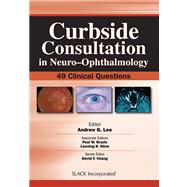
| Dedication | p. v |
| About the Editors | p. xi |
| About the Associate Editors | p. xiii |
| Contributing Authors | p. xv |
| Preface | p. xix |
| How Should a Childhood Optic Nerve Glioma Be Worked Up? | p. 1 |
| How Should an Optic Nerve Sheath Meningioma Be Managed? | p. 5 |
| What Neuroimaging Studies Should I Order? | p. 9 |
| How Should I Evaluate and Manage Suspected Optic Neuritis? | p. 13 |
| What Is the Evaluation of Optic Neuritis? | p. 17 |
| What Is Neuroretinities? | p. 23 |
| How Do You Evaluate Non-Arteritic Anterior Ischemic Optic Neuropathy? | p. 29 |
| How Do You Differentiate Arteritic Anterior Ischemic Optic Neuropathy From Non-Arteritic? | p. 33 |
| How Long Do You Have to Treat Giant Cell Arteritis? | p. 37 |
| What Is the Evaluation of Traumatic Optic Neuropathy? | p. 39 |
| What Is the Evaluation and Management for Papilledema? | p. 43 |
| Is There a Difference in the Management of Pseudotumor Cerebri in Pregnancy? | p. 47 |
| What Is the Evaluation and Management of the High-Flow Carotid Cavernous Fistual? | p. 49 |
| How Do I Manage an Internuclear Ophthalmoplegia? | p. 53 |
| What Is the Evaluation of Ocular Myasthenia Gravis? | p. 57 |
| What Do I Tell My Patients With Ocular Myasthenia About Their Chances of It Progressing to the Rest of Their Body? Do I Need a Neurologist? | p. 61 |
| How Do You Manage Visual Loss in Thyroid Eye Disease? | p. 65 |
| When Do You Use Radiation or Steroids in Thyroid Eye Disease? | p. 69 |
| How Do You Manage Diplopia in Thyroid Eye Disease? | p. 73 |
| Are There Any Treatments for Nystagmus That Work? | p. 77 |
| How Do You Evaluate Downbeat Nystagmus? | p. 81 |
| What Is the Evaluation for Anisocoria? | p. 85 |
| How and When Should I Work Up Horner Syndrome? | p. 89 |
| What Should I Do With a Dilated Pupil? | p. 95 |
| What Is the Evaluation for Episodic Anisocoria? | p. 99 |
| How Do You Manage Toxic and Nutritional Optic Neuropathies? | p. 103 |
| What Are Visual Processing Defects and How Can I Recognize Them? | p. 107 |
| How Do I Manage Headache Syndromes That Come to Me as an Ophthalmologist? | p. 111 |
| What Is the Evaluation of Optic Atrophy? | p. 115 |
| What Do I Do in a Child With Asymmetric Nystagmus? | p. 119 |
| What Is Opsoclonus and How Do I Manage It? | p. 121 |
| What Is Wernick's Encephalopathy and How Does It Affect the Eye? | p. 123 |
| How Do You Manage Postoperative Visual Loss After Spinal Surgery? | p. 127 |
| How Do I Manage Transient Monocular Visual Loss in a Young, Otherwise Healthy Patient? | p. 131 |
| What Is the Evaluation for Transient Monocular Visual Loss in an Older Adult? | p. 135 |
| What Is the Evaluation for a Homonymous Hemianopia? | p. 139 |
| What Is the Evaluation for a Pupil-Involved Third Nerve Palsy? | p. 145 |
| What Is the Evaluation for a Painful Third Nerve Palsy Without a Fixed and Dilated Pupil but With Anisocoria (Partial Pupil Involvement)? | p. 149 |
| How Do You Manage an Isolated and Presumed Vasculopathic Pupil-Sparing Third Nerve Palsy? | p. 153 |
| What Is the Appropriate Evaluation of a Fourth Nerve Palsy? | p. 157 |
| What Is the Appropriate Evaluation in a Patient Suspected of Having a Sixth Nerve Palsy? | p. 161 |
| How Do I Evaluate a Patient With Multiple Ocular Motor Cranial Nerve Palsies? | p. 165 |
| What Is Blepharaospasm? | p. 169 |
| What Is Hemifacial Spasm? | p. 173 |
| How Do You Deal With Nonorganic Visual Loss? | p. 177 |
| How Do You Diagnose and Manage Migraine Aura? | p. 183 |
| How Do I Manage the Low-Flow Carotid Cavernous Fistula? | p. 187 |
| How Do I Recognize Leber's Hereditary Optic Neuropathy? | p. 193 |
| How Do I Manage an Orbital Apex Syndrome? | p. 197 |
| Financial Disclosures | p. 204 |
| Index | p. 209 |
| Table of Contents provided by Ingram. All Rights Reserved. |
The New copy of this book will include any supplemental materials advertised. Please check the title of the book to determine if it should include any access cards, study guides, lab manuals, CDs, etc.
The Used, Rental and eBook copies of this book are not guaranteed to include any supplemental materials. Typically, only the book itself is included. This is true even if the title states it includes any access cards, study guides, lab manuals, CDs, etc.